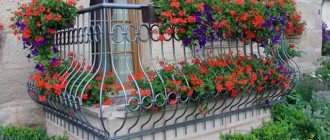With the help of flowering plants, you can turn your balcony into an attractive green corner, where it will be pleasant to relax from the summer heat and bustle of the city. If you choose the right varieties, their flowering will delight you from the first warm days of spring until the onset of autumn frosts. When choosing which flowers to plant on the balcony, do not forget about safety: give preference to special balcony boxes or hanging flower pots - the main thing is that the flower containers are securely fastened and cannot tip over in a gust of wind.
Which ones to plant in the shade?
Despite the dampness, humidity and coolness that are typical of northern balconies, there are many indoor plants that normally tolerate such conditions. There are even plenty to choose from!
Balsam
Impatiens (Impatiens) is a small plant covered with many bright buds of various colors and shades (depending on the variety). On the shady side, it is recommended to give preference to varieties of delicate flowers, since bright ones will still fade.
Begonia
Begonia (Begonia) is considered an ever-blooming perennial, but it will bloom on the balcony only in summer, in warm times. For the winter, it is recommended to either cover it or take it into the house, into a warm place (provided that the balcony is not insulated). It blooms brightly and large, pleasing to the eye. Loves the sun, but feels fine on the shady side (although it blooms smaller).
Thanks to the variety of colors of begonias, you can grow whole bouquets of different flowers by mixing several varieties in one pot.
Fuchsia
Fuchsia is a prolific bloomer with clusters of bright flowers and inconspicuous small green leaves. Flowers dry out in the sun, so a northern balcony is ideal for fuchsia. Despite its brightness and unusualness, this is a rather unpretentious flower.
Find out what other hanging plants are suitable for balconies here.
Cyclamen
Cyclamen looks unusual: a wide, low rosette of dark green leaves, from which a bright large bud sticks out. It prefers diffused light and does not tolerate bright sun, so it feels comfortable on a northern balcony without wind.
Astilbe
Astilbe is distinguished by long thin stems, on top of which there are bright lush inflorescences. Most varieties, different in color and size, do not like the sun and feel great in the shade.
Lobelia
Lobelia tolerates both sun and lack of it. It is unpretentious, does not suffer from dampness, drought and drafts - it can continue to bloom even in these conditions. At the same time, it will not bloom without feeding. Natural nutrition is only enough for the green part.
Viola
Another name: pansy (Viola). Fades in bright sun, but retains rich color in the shade. It needs regular watering and feeding, and then it blooms long and luxuriantly. Due to its small size, viola is often grown in large quantities, placing many pots nearby.
Dicentra
Dicentra is exquisite and features soft purple heart-shaped flowers. In the shade it blooms for a long time, but not abundantly.
It easily tolerates proximity to different crops, so it is often planted in a pot with other plants.
Calceolaria
Or slipper (Calceolaria). Blooms brightly and beautifully even in the shade. Very capricious and suitable only for experienced gardeners. Requires constant care: normalization of temperature and humidity, proper watering, and other special conditions. Thanks for this with unusual lush flowers that are pleasing to the eye.
Primrose
Also called primrose (Primula). These are round, bright flowers with yellow cores that appear in the spring with the first warming. Loves loose and acidic soil, good drainage and regular watering. Blooms best with good, consistent fertilization.
Marigold
Tagetes. They need a deep but narrow pot due to the characteristics of the roots. They bloom closer to summer and delight the eye with bright orange or yellow flowers that open not only in the sun, but also in cloudy weather. They can tolerate both direct sunlight and their absence.
Calendula
Calendula. It is unpretentious and grows equally well on both the sunny and shady sides of the house. It is distinguished by bright orange flowers, which are dotted with its dark green low bushes.
Flowering can be extended by cutting off faded buds - new ones will appear in their place.
Nasturtium
Or capuchin (Tropaeolum). Bright small water lily flowers are gradually replaced by others, which makes flowering continuous. Does not tolerate scorching rays well, although it loves light. Needs regular watering and feeding.
Snapdragon
Antirrhinum. This is a low but wide plant, reminiscent of a blooming fragrant carpet. The advantage is that flowering continues in winter, despite the fact that it freezes.
Nemesia
Nemesia is planted in June, and by August, when it becomes cool, it blooms. These are many colorful bright flowers that look fun, but fragile.
It takes up very little space, so it is suitable for cramped balconies.
Mimulus
Mimulus. It easily tolerates the absence of sun and is even tolerant of slight frosts. It blooms brightly and variegatedly in June-July, by August only green twigs remain.
Molucella
Also called Irish bluebell (Moluccella). In fact, this is a completely green plant: even the bells on it do not differ in color from the stem and leaves. It has thorns, so the choice of location must be approached with caution. Great as a background for bright colors.
Nemophila
Nemophila. Known for its caps of soft blue small flowers, capable of creating a fragrant “carpet”. Does not like sun, drought and poor soil.
Winged tobacco
Nicotiana alata. This is a meter-long flowering bush that exudes a strong, pleasant aroma every night. It blooms only in the shade and closes in the sun. Needs regular watering and fertilization.
Cosmea
Cosmos. White, pink, crimson, lilac, red cosmos flowers bloom in the shade and coolness and delight the eyes of those whose balconies receive little sun. The plant easily tolerates drought, but requires pruning of faded buds - then new ones will appear in their place.
Petunia
Petunia has dozens of varieties of different types and characteristics. For a northern shady balcony, it is recommended to grow tall bushes or hanging varieties so that the plant can absorb enough sun.
Read more about the varieties of petunia and how to plant it on the balcony here.
Torenia
Torenia are variegated bells against a background of soft green leaves. Hates heat and drafts, but feels ideal in the shade without wind. It does not like sudden changes in weather, so it is recommended to bring it indoors when it gets cold (accordingly, the pot should be convenient for such movements).
Dichorysandra
Dichorisandra. Despite its tropical homeland, this plant prefers diffused light and thrives in cool conditions.
The main thing is to choose nutritious soil, regularly fertilize and spray the plant.
Hydrangea
Hydrangea (Hydrangea) looks lush and luxurious, and does not require special care. Shade and coolness are its natural habitat, so the northern balcony is the best place for it in the house. It is only important to water and feed it on time.
Fern
Ferns (Polypodiophyta) love shade and dampness, so they are great for landscaping a northern balcony. It is worth considering that ferns cause allergies and are therefore unsafe for people prone to allergies.
Derbyanka (Blechnum) is especially recommended for balcony cultivation due to its spreading nature - it can protect the apartment from dust and street noise.
Conifers
Coniferous plants tolerate the absence of sun and heat better than deciduous ones. Araucaria (Araucaria) is best suited for a balcony. It is quite tall and spreading, but does not like being adjacent to other plants, so it is placed separately. However, it can replace several other colors.
Myrtle
Myrtle (Myrtus) is a spherical green crown on a long thin stem. It is better to grow it in a shaded but ventilated place. Its flowering is inconspicuous, so it is loved more for its unusual shape.
Khosta
Hosta is a large rosette of glossy green leaves from the center of which stems with delicate buds protrude. Appreciates good drainage and abundant watering, but does not need the sun, preferring shade and humidity.
Mimulus (lipstick)
This lovely plant loves partial shade, so if the sun appears occasionally, then this is what you need. The height of the plant is 25-30 cm, tolerates frost well - down to minus three degrees, loves soil with vermicompost and a high peat content. On such soil the bush forms better and blooms more luxuriantly. Blooms from July to September. Susceptible to aphids.
Planting and care
Shade-loving flowers are usually planted at home as seedlings, and only then sprouted and sufficiently developed plants are planted in the ground on the balcony. It is important not to over-moisten the soil - this can lead to rot and mold. You should also avoid drafts - the temperature is already low.
Despite the lack of light and heat, northern balconies are also suitable for landscaping. It is necessary to take into account certain features, but at the same time it gives you the opportunity to feel like you are in nature, even in a city apartment.
Where to hang hanging flowers on the balcony
Before landscaping a balcony or loggia, you should make maximum use of the free space. Narrow shelves are reinforced along the balcony railing to create a multi-tiered composition.
- Plants that require large amounts of sunlight are placed on the upper shelves.
- At the bottom there are shade-loving crops.
- Use the ceiling of the balcony as well - attach hanging pots, wicker baskets or flowerpots to it.
These containers for growing plants can also be placed on brackets mounted on facade walls or dividing partitions between two adjacent balconies.
Active use of all levels of the balcony provides space to create a green oasis in the middle of the concrete jungle.
Photo gallery
Do you like creativity? Then place hanging flowers, strengthening them in an old boat or an unnecessary bicycle.
Remember that the location of the plants should not interfere with movement on the balcony, because you should be able to enjoy the result of your labors!
Return to content
Benefits of climbing plants
Fast growing and climbing plants have the following advantages:
- They quickly entwine the walls.
- With their help, you can disguise walls with defects.
- Such plants allow you to create an accent in the interior.
After planting, the plants require some care. We must not forget about watering and timely removal of weeds. In preparation for winter, each shoot is strengthened with an earthen tubercle and sawdust. Such a coating will protect the root system in cold weather.
How to choose curly options for a balcony?
When deciding which plants to choose for a small balcony, it is worth considering the factors that affect the growth and flowering of shoots. What matters is whether the room faces the sunny or shaded side. If the room is not glazed, then the planting should be carried out taking into account the strength of the blowing winds. It is better to choose persistent and unpretentious crops.
If the selected space receives a lot of sunshine, then it is worth choosing annual plants: decorative beans, nasturtium or morning glory. For perennials, you can buy Chinese lemongrass or honeysuckle. Clematis is especially beautiful.
Ivy is suitable for shaded areas. It is resistant to strong winds. You can choose girlish grapes, which are characterized by endurance and unpretentiousness.
Viola
Bright violas, or pansies, are found in almost every garden. But you can successfully grow this flower on the balcony. Viola is completely unpretentious and will delight you with flowering until autumn. Usually it is planted on sunny balconies, but there pansies can suffer from the heat. Therefore, the northern one is a very good alternative.
And if the sun hits your balcony even occasionally, pansies will bloom much longer than if they grew in bright light.
Be prepared for the fact that when planted in the shade, the viola will bloom smaller and slightly paler than when grown in the sun.
How to care for viola
Viola loves light and loose soil. You need to water the soil as soon as it dries out a little. Moderate watering will help avoid rot, which affects the tender roots of the viola. To achieve flowering, feed the flower weekly with complex fertilizers and inspect it for pests. And once every 10 days, loosen the soil so that a dry crust does not form on the surface. When planting seedlings, leave at least 15-20 cm between plants so that the roots feel comfortable.
Characteristics of popular types
To begin with, let’s make a small classification of hanging flowers that are grown on the balcony, depending on their perception of the surrounding atmosphere:
- Pansies, nolana and balsam grow well on the shady side of the balcony.
- Verbena, petunia, Moorish bindweed, pelargonium, and bracichoma will rejoice in the bright rays of the sun.
- Dichondra, balsam and scaevola expect increased watering.
- Euphorbia and fortune are not afraid of the wind.
- Pelargonium, ferulleaf string, spurge, and verbena will calmly endure the dry period.
The leaders among the hanging flowers decorating the balcony are petunia and geranium. The variety of colors of ampelous petunia can be observed in parks, cafes, on the facades of houses and of course balconies. One- and two-color plants are very unpretentious, for which they have earned everyone’s love. Similar characteristics are characteristic of geraniums, whose second name is pelargonium.
Warm or cold
When choosing plants, the temperature regime that is maintained on the balcony is also important.
Warm northern balconies
Dichorisandra with blue candle flowers
Shade-tolerant, unpretentious plants that thrive in the temperature range from +18 to +20 °C are selected for cultivation. Unfortunately, there are few such representatives of the green world, but with additional lighting you can safely grow the lion's share of the assortment for warm western and eastern balconies.
I offer you 4 plants that I would place on my balcony:
- Dichorisandra or golden mustache is native to America. In addition to its attractive appearance and unpretentiousness, it is famous for its healing properties and use in folk medicine.
I recommend planting dichorisander in small-volume pots, this will allow the plant to recover faster after trimming the mustache.
- Ruellia requires warmth and moderate light. It will delight you with abundant greenery if you monitor the humidity level, otherwise the leaves become inconspicuous and dull.
Ruellia will surprise you not only with a fluffy head of greenery, but also with pretty flowers
- There are many types of ficus at your disposal, the most popular are lyre-shaped, oak-leaved and sacred. The plant requires annual pruning and replanting, sprinkled with crushed wood ash powder.
- I am sure that you are also familiar with chlorophytum. It is valued for its positive energy and ability to purify the air. When choosing cape, crested or winged chlorophytum, remember that it will require annual replanting.
Good old ficus
Cold verified balconies
Yes, yes, even on such a balcony you can successfully grow flowers with your own hands. Which? Let's look at the table.
| Name | Instructions and recommendations |
| Evergreen araucaria | When you plant it, you have the chance to get a piece of coniferous forest on your own balcony, and on New Year’s Eve even turn it into a traditional Christmas tree.
Cypress and cypress will help create an attractive composition.
|
| Hydrangea | A fairly hardy plant, but will require a little more attention from you during flowering. The flower stalks have an impressive mass, so they require tying.
|
| Myrtle | A symbol of family well-being, which, if trimmed correctly, can turn into a fancy ball, cone or pyramid.
|
| Aucuba | An exotic plant that is grown in pairs. By artificially pollinating peduncles, you can get berries that are similar to red dogwood.
|
Landscaping tips
Pay attention to the interior and exterior - hang balcony boxes with blooming petunias or marigolds outside, and place flowerpots with larger flowers inside.
Check plants regularly for pests - outside the apartment they are more often affected by diseases and insects.
Remove faded buds and dried specimens in a timely manner and form flowers to maintain an aesthetic appearance.
Combine several types in one box: combined flower beds look more interesting.
Living plants are the best decor for a loggia! Provide them with comfortable conditions and proper care to enjoy greenery throughout the summer or even winter!
How to grow clematis
Clematis is considered one of the most beautiful plants; it thrives in small areas. On the balcony you can grow plants with a stem length of up to four meters. It is recommended to place them on a trellis or other support.
Clematis are heat-loving crops that do not tolerate frost. To grow them, you need a significant amount of soil. This will require large containers. Clematis feels comfortable in pots 700 mm high, and the side of the tub should be at least 500 mm. Containers are made of plastic or wood.
When planting clematis, the following rules should be observed:
- When laying the soil, you need to pay attention to quality drainage. The gravel layer must be at least 8 cm.
- The soil is well fertilized.
- To neutralize the composition of the soil for clematis, it is recommended to use large doses of chalk, mineral fertilizers and slaked lime.
To decorate a balcony with flowers, you do not need to use many types at once. It is enough to use several types of annual and perennial plants. Climbing plants are considered the best option for landscaping a balcony.
Source: balkonyi.ru
Primrose
Primrose, or primrose, is a perennial plant with bright, delicate flowers. At the dacha, it is usually planted in the shade under trees or near stones. But even on the northern balcony this flower will develop well if you give it a little attention. Primrose blooms in the spring, but some tall species, such as Byss primrose and Japanese primrose, bloom from June to August.
How to care for primrose on the balcony
Garden primrose easily adapts to life in the shade. It loves loose, slightly acidic soil, so regularly loosen the soil in the flowerpot. Regular watering is required. The soil under the bushes can be mulched with gravel. During the season, feed the plant with complex fertilizers. Remove faded inflorescences and faded leaves - and the primrose will delight you with its flowering for a long time!
Astilbe
Astilbe is a luxurious herbaceous perennial with delicate inflorescences and graceful leaves. Low-growing varieties of various shades are suitable for the balcony. Plants will look great in large pots that can be placed on the floor or stand. In different species, flowering occurs in June, July or August.
How to care for astilbe on the balcony
Most of all, astilbe does not like dryness, so it needs to be watered regularly, making sure that the soil is always moist. For successful flowering, plant the plant in fertile soil. The rhizome of the plant is close to the surface. To prevent it from drying out, mulch the soil in the pot.
From spring to autumn, astilbe needs feeding with potassium and phosphorus (twice a month). You can use store-bought complex fertilizers according to the instructions. After flowering, carefully cut off the inflorescences.
- The best varieties of astilbe: photos, names, descriptions
A selection of the most beautiful varieties of astilbe with photos and detailed descriptions.
Composition for a shady balcony made of plants with bright leaves
On the balcony, where there is little sun, you can create a magnificent composition. Look at the composition in an ordinary fruit basket that we had left over after the holiday.
Photo and balcony of the author of the article
I composed a composition for a shady balcony, the sun is very rare there, the balcony is north-facing and the sun's rays only hit it for a few minutes a day. Cart HERE. Good luck.
Torenia
Bell-flowered torenia is very sensitive to its environment. So, the plant does not tolerate heat and drafts, and may even shed its leaves. Its flowers are less capricious and bloom luxuriously from June to August. The buds of gloxinia are reminiscent of their velvety quality. Thanks to its branched stems, torenia looks great as an hanging flower. There are many species of this plant in nature. The most popular is Fournier's torenia, an annual plant with branched leaves.
It is better to grow torenia in small pots, so that when the weather changes, you can bring them indoors.
How to care for torenia on the balcony
It is important that the soil in the pot is always moist. But you need to water carefully so that water does not get on the leaves, otherwise they may rot. Add a little sand or charcoal to the soil - torenia will like it. The plant needs to be fed only during the growth period with conventional complex fertilizers. Diseases and pests rarely affect the flower, but it is still worth inspecting the leaves periodically. For prevention, regularly remove weeds and wilted flowers. To make the torenia bush grow beautiful, pinch the tops of the shoots.











